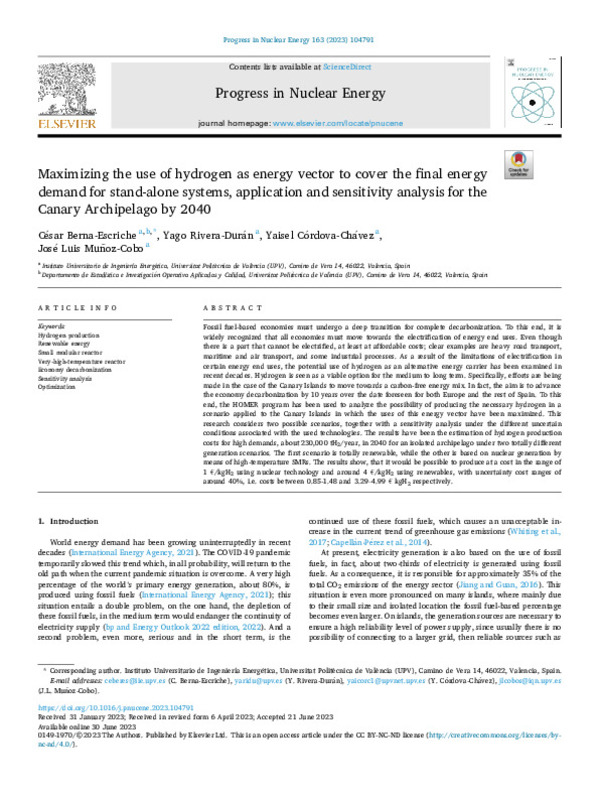JavaScript is disabled for your browser. Some features of this site may not work without it.
Buscar en RiuNet
Listar
Mi cuenta
Estadísticas
Ayuda RiuNet
Admin. UPV
Maximizing the use of hydrogen as energy vector to cover the final energy demand for stand-alone systems, application and sensitivity analysis for the Canary Archipelago by 2040
Mostrar el registro sencillo del ítem
Ficheros en el ítem
| dc.contributor.author | Berna, C.
|
es_ES |
| dc.contributor.author | Rivera-Durán, Yago
|
es_ES |
| dc.contributor.author | Córdova-Chávez, Yaisel
|
es_ES |
| dc.contributor.author | Muñoz-Cobo, J. L.
|
es_ES |
| dc.date.accessioned | 2024-02-08T19:03:19Z | |
| dc.date.available | 2024-02-08T19:03:19Z | |
| dc.date.issued | 2023-09 | es_ES |
| dc.identifier.issn | 0149-1970 | es_ES |
| dc.identifier.uri | http://hdl.handle.net/10251/202472 | |
| dc.description.abstract | [EN] Fossil fuel-based economies must undergo a deep transition for complete decarbonization. To this end, it is widely recognized that all economies must move towards the electrification of energy end uses. Even though there is a part that cannot be electrified, at least at affordable costs; clear examples are heavy road transport, maritime and air transport, and some industrial processes. As a result of the limitations of electrification in certain energy end uses, the potential use of hydrogen as an alternative energy carrier has been examined in recent decades. Hydrogen is seen as a viable option for the medium to long term. Specifically, efforts are being made in the case of the Canary Islands to move towards a carbon-free energy mix. In fact, the aim is to advance the economy decarbonization by 10 years over the date foreseen for both Europe and the rest of Spain. To this end, the HOMER program has been used to analyze the possibility of producing the necessary hydrogen in a scenario applied to the Canary Islands in which the uses of this energy vector have been maximized. This research considers two possible scenarios, together with a sensitivity analysis under the different uncertain conditions associated with the used technologies. The results have been the estimation of hydrogen production costs for high demands, about 230,000 tH2/year, in 2040 for an isolated archipelago under two totally different generation scenarios. The first scenario is totally renewable, while the other is based on nuclear generation by means of high-temperature SMRs. The results show, that it would be possible to produce at a cost in the range of 1 euro/kgH2 using nuclear technology and around 4 euro/kgH2 using renewables, with uncertainty cost ranges of around 40%, i.e. costs between 0.85-1.48 and 3.29-4.99 euro kgH2 respectively. | es_ES |
| dc.description.sponsorship | The authors would like to express their gratitude to the Generalitat Valenciana (Spain) for its support under the Santiago Grisolia Program/2018/140. The authors also would like to extend their gratitude to the Ministerio de Economia, Industria y Competitividad and by Agencia Nacional de Investigacion under the FPI grant BES-2017-080031. | es_ES |
| dc.language | Inglés | es_ES |
| dc.publisher | Elsevier | es_ES |
| dc.relation.ispartof | Progress in Nuclear Energy | es_ES |
| dc.rights | Reconocimiento - No comercial - Sin obra derivada (by-nc-nd) | es_ES |
| dc.subject | Hydrogen production | es_ES |
| dc.subject | Renewable energy | es_ES |
| dc.subject | Small modular reactor | es_ES |
| dc.subject | Very-high-temperature reactor | es_ES |
| dc.subject | Economy decarbonization | es_ES |
| dc.subject | Sensitivity analysis | es_ES |
| dc.subject | Optimization | es_ES |
| dc.subject.classification | ESTADISTICA E INVESTIGACION OPERATIVA | es_ES |
| dc.title | Maximizing the use of hydrogen as energy vector to cover the final energy demand for stand-alone systems, application and sensitivity analysis for the Canary Archipelago by 2040 | es_ES |
| dc.type | Artículo | es_ES |
| dc.identifier.doi | 10.1016/j.pnucene.2023.104791 | es_ES |
| dc.relation.projectID | info:eu-repo/grantAgreement/GVA//GRISOLIAP%2F2018%2F140//AYUDA SANTIAGO GRISOLIA PROYECTO: EXPERIMENTACIÓN Y MODELACIÓN DE DESCARGAS DE MEZCLAS DE VAPOR Y GASES INCONDENSABLES/ | es_ES |
| dc.relation.projectID | info:eu-repo/grantAgreement/MINECO//BES-2017-080031/ | es_ES |
| dc.rights.accessRights | Abierto | es_ES |
| dc.contributor.affiliation | Universitat Politècnica de València. Facultad de Administración y Dirección de Empresas - Facultat d'Administració i Direcció d'Empreses | es_ES |
| dc.description.bibliographicCitation | Berna, C.; Rivera-Durán, Y.; Córdova-Chávez, Y.; Muñoz-Cobo, JL. (2023). Maximizing the use of hydrogen as energy vector to cover the final energy demand for stand-alone systems, application and sensitivity analysis for the Canary Archipelago by 2040. Progress in Nuclear Energy. 163. https://doi.org/10.1016/j.pnucene.2023.104791 | es_ES |
| dc.description.accrualMethod | S | es_ES |
| dc.relation.publisherversion | https://doi.org/10.1016/j.pnucene.2023.104791 | es_ES |
| dc.type.version | info:eu-repo/semantics/publishedVersion | es_ES |
| dc.description.volume | 163 | es_ES |
| dc.relation.pasarela | S\502426 | es_ES |
| dc.contributor.funder | Generalitat Valenciana | es_ES |
| dc.contributor.funder | Ministerio de Economía, Industria y Competitividad | es_ES |
| dc.contributor.funder | Universitat Politècnica de València |








